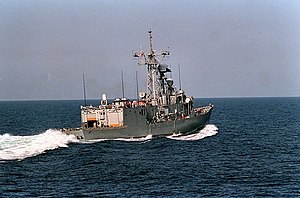
The Kuwait Armed Forces are the military forces of the State of Kuwait. They consist of the Kuwait Air Force, the Kuwait Army, the Kuwait Navy & the Kuwait National Guard. The governing bodies are the Kuwait Ministry of Defense, the Kuwait Ministry of Interior, and the Kuwait Fire Service Directorate. The Emir of Kuwait is the commander-in-chief of all defense forces while the Crown Prince is the deputy commander.

The Gulf War was an armed conflict between Iraq and a 42-country coalition led by the United States. The coalition's efforts against Iraq were carried out in two key phases: Operation Desert Shield, which marked the military buildup from August 1990 to January 1991; and Operation Desert Storm, which began with the aerial bombing campaign against Iraq on 17 January 1991 and came to a close with the American-led Liberation of Kuwait on 28 February 1991.
This is a list of aviation-related events from 1987.
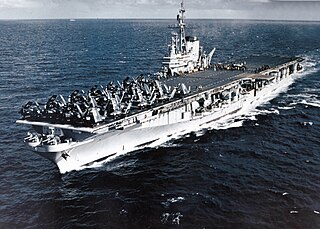
USS Midway (CVB/CVA/CV-41) is an aircraft carrier, formerly of the United States Navy, the lead ship of her class. Commissioned 8 days after the end of World War II, Midway was the largest warship in the world until 1955, as well as the first U.S. aircraft carrier too big to transit the Panama Canal. She operated for 47 years, during which time she saw action in the Vietnam War and served as the Persian Gulf flagship in 1991's Operation Desert Storm. Decommissioned in 1992, she is now a museum ship at the USS Midway Museum, in San Diego, California, and is the only remaining inactive U.S. aircraft carrier that is not an Essex-class aircraft carrier.

HMS Cardiff was a British Type 42 destroyer and the third ship of the Royal Navy to be named in honour of the Welsh capital city of Cardiff.

USS Oldendorf (DD-972), named for Admiral Jesse B. Oldendorf USN, was a Spruance-class destroyer built by the Ingalls Shipbuilding Division of Litton Industries at Pascagoula, Mississippi.

USS Merrill (DD-976), named for Rear Admiral Aaron Stanton Merrill USN (1890–1961), was a Spruance-class destroyer that entered service with the United States Navy in 1978. Merrill served as the US Navy's test platform for the Tomahawk cruise missile. In the 1980s, the destroyer took part in Operation Earnest Will in the Persian Gulf during heightened tensions with Iran. The destroyer was decommissioned in 1998. The vessel was used as a target ship in 2003 and sunk off Hawaii in 2003.
This is a list of aviation-related events from 1991.
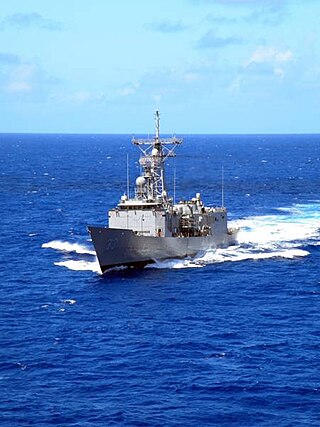
USS Jarrett (FFG-33), was the twenty-fifth ship of the Oliver Hazard Perry-class guided missile frigates, was named for Vice Admiral Harry B. Jarrett (1898–1974).
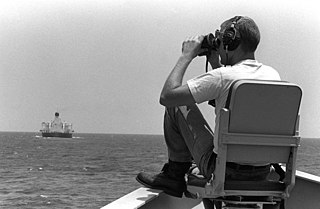
Operation Earnest Will was an American military protection of Kuwaiti-owned tankers from Iranian attacks in 1987 and 1988, three years into the Tanker War phase of the Iran–Iraq War. It was the largest naval convoy operation since World War II.

Operation Praying Mantis was an attack on 18 April 1988 by the United States Armed Forces within Iranian territorial waters in retaliation for the Iranian naval mining of international waters in the Persian Gulf during the Iran–Iraq War and the subsequent damage to an American warship.
The names of commissioned ships of the United States Navy all start with USS, for United States Ship. Non-commissioned, primarily civilian-crewed vessels of the U.S. Navy under the Military Sealift Command have names that begin with USNS, standing for United States Naval Ship. A letter-based hull classification symbol is used to designate a vessel's type. The names of ships are selected by the Secretary of the Navy. The names are those of states, cities, towns, important persons, important locations, famous battles, fish, and ideals. Usually, different types of ships have names originated from different types of sources.

USS Nicholas (FFG-47), an Oliver Hazard Perry-class frigate, was the third ship of the United States Navy to be named for Major Samuel Nicholas, the first commanding officer of the United States Marines. A third-generation guided missile frigate of the Oliver Hazard Perry class, she was laid down as Bath Iron Works hull number 388 on 27 September 1982 and launched 23 April 1983. Sponsor at her commissioning there on 10 March 1984 was the same Mrs. Edward B. Tryon who sponsored DD 449 in 1942.

The Sea Skua is a British lightweight short-range air-to-surface missile (ASM) designed for use from helicopters against ships. It was primarily used by the Royal Navy on the Westland Lynx. Although the missile is intended for helicopter use, Kuwait employs it in a shore battery and on their Umm Al Maradem fast attack craft.

Sabalan is an Alvand-class frigate of the Islamic Republic of Iran Navy. She was launched in 1969.

Naval tactics and doctrine is the collective name for methods of engaging and defeating an enemy ship or fleet in battle at sea during naval warfare, the naval equivalent of military tactics on land.
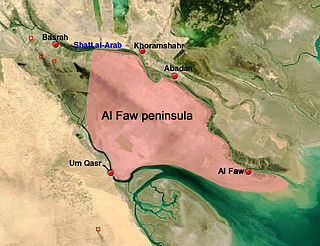
The Battle of Al Faw was one of the first battles of the Iraq War; it took place March 20-24, 2003.

The Gulf War of 1990–1991 included air campaign, as the air forces of the coalition carried an extensive aerial bombing campaign from 17 January 1991 to 23 February 1991 against Iraq. Spearheaded by the United States, the coalition flew over 100,000 sorties, dropping 88,500 tons of bombs, widely destroying military and civilian infrastructure. The air campaign was commanded by United States Air Force (USAF) lieutenant general Chuck Horner, who briefly served as Commander-in-Chief—Forward of U.S. Central Command while general Norman Schwarzkopf was still in the United States. The British air commanders were Air Vice-Marshal Andrew Wilson and Air Vice-Marshal Bill Wratten. The air campaign had largely finished by 23 February 1991 when the coalition invasion of Kuwait took place.
The Battle of Bubiyan was a naval engagement of the Gulf War that occurred in the waters between Bubiyan Island and the Shatt al-Arab marshlands, where the bulk of the Iraqi Navy, which was attempting to flee to Iran, much like the Iraqi Air Force, was engaged and destroyed by Coalition warships and aircraft.
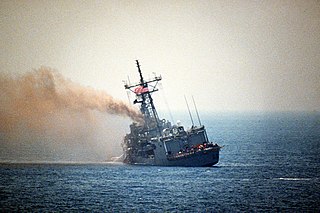
The USS Stark incident occurred during the Iran–Iraq War on 17 May 1987 in Persian Gulf, when an Iraqi jet aircraft fired two Exocet missiles at the U.S. frigate USS Stark. A total of 37 United States Navy personnel were killed or later died as a result of the attack, and 21 were injured.
